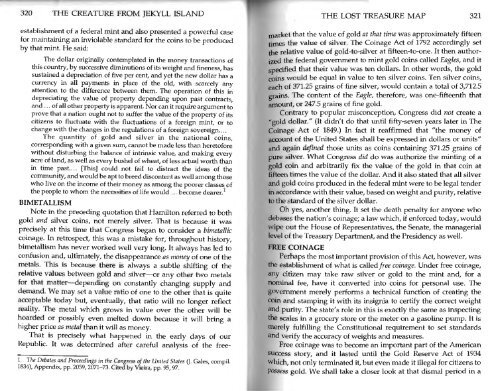You also want an ePaper? Increase the reach of your titles
YUMPU automatically turns print PDFs into web optimized ePapers that Google loves.
320 THE CREATURE FROM JEKYLL ISLAND THE LOST TREASURE MAP 321<br />
establishment of a federal mint and also presented a powerful case<br />
for maintaining an inviolable standard for the coins to be produced<br />
by that mint. He said:<br />
The dollar originally contemplated in the money transactions of<br />
this country, by successive diminutions of its weight and fineness, has<br />
sustained a depreciation of five per cent, and yet the new dollar has a<br />
currency in all payments in place of the old, with scarcely any<br />
attention to the difference between them. The operation of this in<br />
depredating the value of property depending upon past contracts,<br />
and ...<br />
of all other property is apparent. Nor can it require argument to<br />
prove that a nation ought not to suffer the value of the property of its<br />
citizens to fluctuate with the fluctuations of a foreign mint, or to<br />
change with the changes in the regulations of a foreign sovereign.. .<br />
The quantity of gold and silver in the national coins,<br />
corresponding with a given sum, cannot be made less than heretofore<br />
without disturbing the balance of intrinsic value, and making every<br />
acre of land, as well as every bushel of wheat, of less actual worth than<br />
in time past.... [This] could not fail to distract the ideas of the<br />
community, and would be apt to breed discontent as well among those<br />
who live on the income of their money as among the poorer classes of<br />
the people to whom the necessities of life would . . . become dearer. 1<br />
BIMETALLISM<br />
Note in the preceding quotation that Hamilton referred to both<br />
gold and silver coins, not merely silver. That is because it was<br />
precisely at this time that Congress began to consider a bimetallic<br />
coinage. In retrospect, this was a mistake for, throughout history,<br />
bimetallism has never worked well very long. It always has led to<br />
confusion and, ultimately, the disappearance as money of one of the<br />
metals. This is because there is always a subtle shifting of the<br />
relative values between gold and silver—or any other two metals<br />
for that matter—depending on constantly changing supply and<br />
demand. We may set a value ratio of one to the other that is quite<br />
acceptable today but, eventually, that ratio will no longer reflect<br />
reality. The metal which grows in value over the other will be<br />
hoarded or possibly even melted down because it will bring a<br />
higher price as metal than it will as money.<br />
That is precisely what happened in the early days of our<br />
Republic. It was determined after careful analysis of the free-<br />
1. Vie Debates and Proceedings in the Congress of the United States (J. Gales, compil.<br />
1834), Appendix, pp. 2059, 2071-73. Cited by Vieira, pp. 95, 97.<br />
•<br />
market that the value of gold at that time was approximately fifteen<br />
times the value of silver. The Coinage Act of 1792 accordingly set<br />
the relative value of gold-to-silver at fifteen-to-one. It then authorized<br />
the federal government to mint gold coins called Eagles, and it<br />
specified that their value was ten dollars. In other words, the gold<br />
courts would be equal in value to ten silver coins. Ten silver coins,<br />
each of 371.25 grains of fine silver, would contain a total of 3,712.5<br />
grains. The content of the Eagle, therefore, was one-fifteenth that<br />
amount, or 247.5 grains of fine gold.<br />
Contrary to popular misconception/ Congress did not create a<br />
"gold dollar." (It didn't do that until fifty-seven years later in The<br />
Coinage Act of 1849.) In fact it reaffirmed that "the money of<br />
account of the United States shall be expressed in dollars or units"<br />
and again defined those units as coins containing 371.25 grains of<br />
pure silver. What Congress did do was authorize the minting of a<br />
gpld coin and arbitrarily fix<br />
the value of the gold in that coin at<br />
fifteen times the value of the dollar. And it also stated that all silver<br />
and gold coins produced in the federal mint were to be legal tender<br />
in accordance with their value, based on weight and purity, relative<br />
to the standard of the silver dollar.<br />
Oh yes, another thing. It set the death penalty for anyone who<br />
debases the nation's coinage; a law which, if enforced today, would<br />
wipe out the House of Representatives, the Senate, the managerial<br />
level of the Treasury Department, and the Presidency as well.<br />
FREE COINAGE<br />
Perhaps the most important provision of this Act, however, was<br />
the establishment of what is called free coinage. Under free coinage,<br />
any citizen may take raw silver or gold to the mint and, for a<br />
nominal fee, have it converted into coins for personal use. The<br />
government merely performs a technical function of creating the<br />
coin and stamping it with its insignia to certify the correct weight<br />
and purity. The state's role in this is exactly the same as inspecting<br />
the scales in a grocery store or the meter on a gasoline pump. It is<br />
merely fulfilling<br />
the Constitutional requirement to set standards<br />
and verify the accuracy of weights and measures.<br />
Free coinage was to become an important part of the American<br />
success story, and it lasted until the Gold Reserve Act of 1934<br />
which, not only terminated it, but even made it illegal for citizens to<br />
possess gold. We shall take a closer look at that dismal period in a


